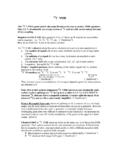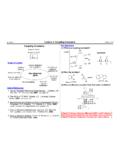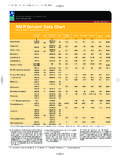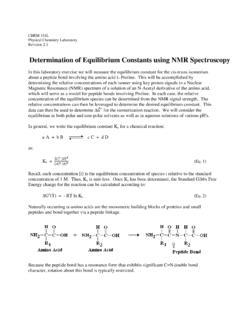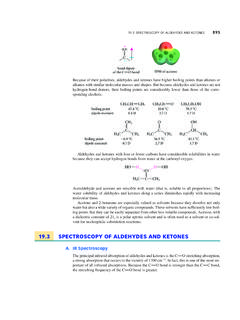Transcription of hsqc topspin ver2 - Columbia University
1 1. hsqc and HMBC for topspin These experiments are only possible on the 400 and 500. These experiments can be used to correlate both carbon-proton and nitrogen-proton. The procedure for 15N and any differences from carbon are discussed at the bottom of this handout. hsqc - Heteronuclear Multiple Quantum Correlation. This 2D experiment correlates the chemical shift of proton with the chemical shift of the directly bonded carbon. On the bottom axis is a proton spectrum and on the other is a carbon. Cross peaks give the shift of the corresponding proton and carbon. This experiment utilizes the one-bond coupling between carbon and proton (J=120-215 Hz). HMBC - Heteronuclear Multiple Bond Correlation. This experiment utilizes multiple-bond couplings over two or three bonds (J=2-15Hz.)
2 Cross peaks are between protons and carbons that are two or three bonds away (and sometimes up to four or five bonds away). Direct one-bond cross-peaks are suppressed. This experiment is analogous to the proton-proton COSY experiment in that it provides connectivity information over several bonds. 13C hsqc and 13C HMBC spectra of sucrose and 15N HMBC of 1-methylpyrazole are shown at the bottom of this handout. It is useful although not necessary to have already taken a carbon spectrum prior to taking hsqc or HMBC. This 1D can be used as a projection for the 2D. A 1D carbon spectrum , acquired from another NMR (like the 300wb), can be used as a projection. It is faster, however, to acquire an entire 2D hsqc . spectrum than a single 1D carbon spectrum and thus, sometimes, it is impossible to obtain a 1D carbon while a 2D hsqc is possible.
3 This is because these 2D experiments are proton-detected and have much higher intrinsic sensitivity than carbon (this is not an effect from the differing abundances of proton and carbon). About sample size, tubes, and sensitivity: When sample quantity is very limited, it is advantageous to limit the amount of solvent in which it is dissolved. If a normal 5mm tube is used, however, this cannot be less than about 500 L without causing serious lineshape (shimming) problems and the attendant loss of signal-to-noise. When one reduces the solvent quantity in a normal 5mm tube, it is important that the sample be centered within the coil. To do this, center the sample about the scored line on the plastic depth gauge. There are special tubes (made by Shigemi) that can be used to restrict the active solvent volume without causing line shape problems.
4 They are available from or Aldrich for a higher price. See John Decatur. Choice of hsqc experiments The following hsqc experiments are possible. The choice is made when you read in parameters with the rpar command. I recommend the edited version for normal work but if sensitivity is a concern, then use the standard hsqc . Parmeter set Experiment edited hsqc with CH and CH3 carbons up, CH2 carbons down standard hsqc . hsqc -TOCSY gives a TOCSY spectrum resolved into the carbon dimension John Decatur Version 10/4/2011. 2. hsqc Procedure 1. Do not spin the sample. Lock, shim and take a normal 1D proton spectrum . Be sure to tune the proton channel of the probe (wobb). Determine the proton spectral region to be used - values of sw and o1p. sw is the spectral width and o1p is the center of the spectrum .
5 For example, if you have peaks over the range 1. to 6 ppm, the optimum region is from to ppm. Always leave at least ppm on the edges of the spectrum . The value for sw is then 6 ppm and o1p is ppm. 2. Note the file name of the 1D proton spectra taken above. You may wish to use it as the F2 projection for the 2D plot. 3. Type new to change the filename, or preferably, simply increment the experiment number. 4. Read in the parameters for the hsqc experiment by typing rpar or or Type getprosol to update the pulse parameters. 5. Type wobb and tune the carbon channel of the probe (The carbon channel comes up on the wobb screen when the hsqc parameters have been read in). 6. The parameters below may be changed. Click AcquPars. The F2 column refers to the proton (direct).
6 Dimension and F1 column refers to the carbon (indirect) dimension. The normal range for the carbon spectral width is from 0 -165 ppm since carbonyls do not usually have directly attached protons. If you suspect you have an aldehyde, then the carbon range should increased to include up to 200 ppm or so. ns - number of scans. By default =1 but this can be increased to give greater signal-to-noise. [the rest are optional]. O1p [ppm] - center of proton spectrum sw [ppm]for F2 - proton spectral width O2P [ppm]- center of carbon spectrum sw [ppm] for F1 - carbon spectral width td for F1 - # of points in F1 dimension (# of FID's). fidres - digital resolution. Should be 3-5Hz/pt in F2 . Should be 20-80 Hz/pt in F1. Fidres is given by the ratio sw/td. Set the values of td in F1 and F2 accordingly.
7 The digital resolution should be set according to your needs, , use better (lower Fidres) resolution if are you interested in carbons that have nearly identical shifts and nearly identical proton shifts. Better digital resolution in F1 dimension requires longer experimental time. Often 80Hz/pt is sufficient. 6. Type expt to determine the time required for the experiment. Values of td in F1 and ns greatly affect the time. 7. Type zg to acquire data. Do not type rga or start. You will see the lock signal fall and rise. This is normal. PROCESSING. When data acquisition is complete, type xfb to transform the data. You may transform the data before the acquisition is finished but the resolution of the 2D spectrum will be reduced. (Don't forget to re transform after the experiment is finished).
8 Display control John Decatur Version 10/4/2011. 3. To expand around a region, simply depress the left mouse button and drag the box around the desired region. To return to the full spectrum , click . To adjust the intensity, use Phasing The hsqc spectrum that you have just run is phase sensitive. You must phase it. An out-of-phase spectrum will look strange and will show dramatic intensity differences on either side of all peaks. To phase a 2D spectrum , one extracts individual 1D rows or columns and phases the 1D spectra. The columns and the rows must both be phased and they must be phased separately. If you have run the edited version, the color of the cross peak indicates the phase and thus the multiplicity. Blue and yellow/green represent opposite phase.
9 CH and CH3 will have one color (yellow/green) and CH2. will have the other (blue). When printing with a black-and-white printer, the color information will have to be added by hand by the user (You!). Click to enter phasing. Phase the rows first. Position the cursor on a row that contains peaks. Click the right mouse button and select add. Then position the cursor on a row with a peak that has a different shift than the first, and right click and select add. The idea is to choose rows such that the peaks cover a large shift range. You may add more rows but usually two in sufficient. To phase rows, click . There will now be a red line on the largest peak. Adjust its phase using the zero-order button, . Then adjust the phase of other peaks in the other row(s) using the first-order button.
10 Click to save and return. Click to repeat the above process on columns. The columns will often not need much phase correction. When finished, click to exit phasing. NOTE to MestreNova users: Automatic phasing usually works. Under Processing, phase correction, select automatic along F2 and then automatic along F1 . Linear Prediction (optional). Linear prediction is a powerful method of improving the resolution of 2D spectra. Normally the FID in the F1 dimension is not fully sampled it is cut off. To sample it more completely requires more points (greater TD in F1) and a longer experiment time. Each doubling of TD (in F1) doubles the number of FIDs and thus requires a doubling of experimental time. Linear prediction is a processing method which predicts these cut-off points.










